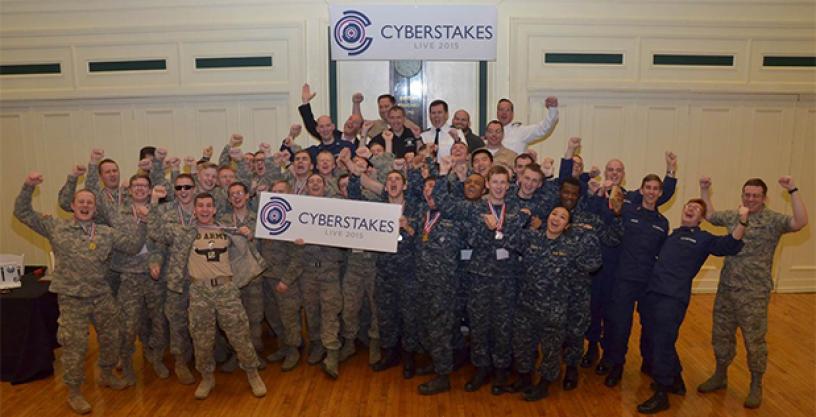
In a three-day contest, Cadets and Midshipmen demonstrate the skills, dedication and teamwork needed to protect the nation’s information and communications networks
Feb 4, 2015
Pittsburgh this weekend offered a look into the future of cybersecurity, with students from each of the nation’s Service academies scrambling to protect their computer systems, find adversaries’ vulnerabilities and exploit them in the second annual CyberStakes Live competition, sponsored by DARPA. More than 40 students participated in this year’s event, which tested teams’ and individuals’ abilities in numerous core cybersecurity skills and culminated in two exciting Capture the Flag (CTF) contests modeled after the global tournaments that attract many of the world’s top cybersecurity experts.
With cybersecurity an increasing priority, the Defense Department is working to achieve its goal of integrating 6,000 cybersecurity experts into combat commands by 2016. Meeting that goal requires building a pipeline for training and education, particularly for the future officers who will be responsible for overseeing protection of the cyber domain. To help overcome these challenges, DARPA last year launched its Service Academy CyberStakes effort, which this year held its CyberStakes Live final event at the Soldiers and Sailors Memorial Hall & Museum in Pittsburgh.
To prepare for the competition, more than 70 Cadets, Midshipmen and faculty from the U.S. Air Force Academy, U.S. Military Academy, U.S. Naval Academy and the U.S. Coast Guard Academy have honed their cybersecurity skills for the past five months under the tutelage of world-class experts. The students got to show what they’d learned in the CyberStakes’ two distinct events. The first, CyberStakes Online, took place last October and had participants solve remote, game-style challenges that addressed essential cybersecurity topics, including forensics, cryptography and reverse engineering.
CyberStakes Online helped prepare the students for CyberStakes Live, a decathlon-style computer security competition that pitted the 10 best teams—three from each Service Academy and one from the Coast Guard Academy—head to head over three days. A full list of events and results is available at http://go.usa.gov/h5pR.
“It’s crucially important that our military leaders have deep technical skills and understand how adversaries could exploit cyber vulnerabilities to subvert the security of our systems,” said Daniel Ragsdale, DARPA program manager. “To that end, the Service Academy CyberStakes seeks to teach future officers how to rapidly acquire and apply the evolving knowledge and skills they need to defend our increasingly complex and interconnected information and communication infrastructures.”
Based on the success of last year’s CyberStakes, the Coast Guard decided to participate for the first time this year and DARPA added two new areas of competition: one testing skills in data forensics and the other—at the strong request of last year’s players—a Joint Team CTF competition with new teams incorporating students from multiple academies.
All the academies exceeded expectations overall and especially in the two CTFs, Ragsdale said, and performance was particularly impressive in the CyberStakes Live’s big finale: the mixed-academy Joint Team CTF. The CTFs are the most difficult events because they require students to apply all their skills in real time in response to human adversaries, not static code. But the Joint Team CTF added an extra challenge by dividing established teams, which required the new teams to figure out on the fly each member’s strengths and responsibilities while accomplishing their mission—skills essential to real-world joint operations.
“In the crucible of competition, the students got the chance to demonstrate the full spectrum of offense- and defense-related capabilities, as well as adaptability and agility in solving problems under stress,” Ragsdale said. “The students had tremendous fun and put in hundreds of hours of work for no academic credit—just the chance to compete and learn extraordinary things that they may not have been exposed to in a traditional undergraduate computer science curriculum. I could not have been more impressed.”
The CyberStakes is half of DARPA’s two-pronged Service Academy Competition Pilot effort, which aims to better cultivate the great potential of young officers-to-be and encourage their career-long collaboration with DARPA. It complements the DARPA Service Academy Innovation Challenge, a competition to encourage U.S. military academy students to develop practical, potentially transformative technologies that could address challenges facing the U.S. military. Nine teams—three from each Service Academy—are scheduled to square off in the second annual competition on April 28, 2015, at DARPA’s offices in Arlington, Va.
This is the last year DARPA is sponsoring the Competition Pilot effort, so the agency is actively seeking transition partners within the Defense Department, Ragsdale said. The goal is to continue both competitions and potentially expand them, both within the Service academies and to include students in Reserve Officer Training Corp (ROTC) programs at other colleges and universities.
# # #
Associated images posted on www.darpa.mil and video posted at www.youtube.com/darpatv may be reused according to the terms of the DARPA Usage Policy, available here: http://go.usa.gov/nYr.
Tweet @darpa
